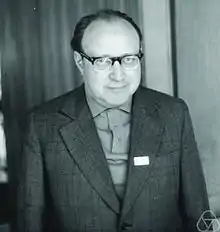尤金·登金
尤金·登金(俄語:,英語:,1924年5月11日-2014年11月14日),蘇聯及美國數學家,於概率論和代數作出重要貢獻,特別是半單李群、李代數和馬可夫過程。登金圖、登金系統、登金引理是以他命名。
| 尤金·登金 | |
|---|---|
 尤金·登金,1976年 | |
| 原文名 | |
| 出生 | 1924年5月11日 蘇聯列寧格勒 |
| 逝世 | 2014年11月14日(90歲) 美國紐約伊薩卡 |
| 居住地 | 美國紐約伊薩卡 |
| 公民权 | 蘇聯、美國 |
| 母校 | 莫斯科國立大學 |
| 奖项 | Leroy P. Steele Prize (1993) |
| 科学生涯 | |
| 研究领域 | 代數和概率論 |
| 机构 | 莫斯科國立大學 中央經濟數學研究所 康奈爾大學 |
| 博士导师 | 安德雷·柯爾莫哥洛夫 |
| 博士生 | Nicolai V. Krylov Igor Girsanov Fridrikh Karpelevich Anatoliy Skorokhod Ernest Vinberg Complete List |
生平
登金生於列寧格勒,1935年他全家被流放到哈薩克。[1]兩年後,登金13歲時,父親在古拉格集中營失蹤。[2][1]
莫斯科國立大學
1940年,16歲的登金入讀莫斯科國立大學。二次大戰時,他因視力差豁免兵役。他在1945年獲碩士,1948年獲博士,在大學裏擔任助理教授,但因為他的政治背景不良,直到1954年斯大林死後,他才獲得固定教職。他的父親的遭遇,和他的猶太血統,令到他的學術路途受到阻撓。他的博士導師安德雷·柯爾莫哥洛夫出面交涉,他才得以完成學業獲得教職。[1]
數學成就
登金在代數和概率論,數學中這兩個非常不同的領域,都作出根本貢獻,是數學界極少有的例子。[5]他的數學工作的代數時期,是從1944年至1954年,但在此時,他的概率主題已經出現。[6]的確,他發表的第一篇論文是與N. A. Dmitriev合著,解決了轉移矩陣(stochastic matrix)的特徵值的一個問題。這個問題是在馬爾可夫鏈的柯爾莫哥洛夫討論班中提出的,當時登金和Dmitriev是本科生。[6]
李理論
當登金在莫斯科國立大學讀書時,他參加了伊斯拉埃爾·蓋爾范德的李群討論班。1944年蓋爾范德著登金根據赫爾曼·外爾和Bartel Leendert van der Waerden的論文,準備一篇關於半單李群的結構和分類的概覽。登金覺得這些論文很難讀懂,他為了更好地理解當中的結果,創造了根系中的「單根」概念。他用登金圖的形式代表各對單根之間的角。這樣他得到了複半單李代數的分類的更簡潔描述。[7]Bertram Kostant提及登金的1947年的論文「半單李代數的結構」,寫到:
這篇論文中,登金只用到基礎數學,從幾乎什麼都沒有開始,出色而優美地發展出半單李代數的結構和工具。他在論文中做到的,是把當時仍很神秘的題目,變成了美麗而強大的數學。[8]
——Bertram Kostant,"Selected papers", p. 363
登金的1952年有重大影響的論文「半單李代數的半單子代數」,載有龐大的表格和列表,研究特殊李代數的子代數。
獎項和榮譽
著作
- . Prentice-Hall. 1961.[12]
- . Grundlehren der mathematischen Wissenschaften, Band 108. Springer Verlag. 1961.[12]
- . Grundlehren der mathematischen Wissenschaften. Springer Verlag. 1965.
- . Grundlehren der mathematischen Wissenschaften. Springer Verlag. 1979.
- . London Math. Soc. Lecture Notes Series, 54. Cambridge University Press. 1982.
- Dynkin, Eugene B. Yushkevich, A. A.; Seitz, G. M.; Onishchik, A. L. , 编. . Providence, R.I.: American Mathematical Society. 2000 [2014-11-19]. ISBN 978-0-8218-1065-1. MR 1757976. (原始内容存档于2016-04-14).
- . AMS Colloquium Publications. 2002.[13]
- . American Mathematical Society. 2004.
參見
- 代數:
- Affine Dynkin diagram
- Coxeter–Dynkin diagram
- Dynkin index
- Dynkin–Specht–Wever Lemma
- 概率論:
- Dynkin's formula
- Dynkin system
註釋
- Dynkin (2000, p. xiii)
- Vvedenskaya, N. D.; Dobrushin, R. L.; Onishchik, A. L.; Uspenskiĭ, V. A. . Russian Math. Surveys. 1994, 49 (4): 183–191. MR 1309461. doi:10.1070/rm1994v049n04abeh002411.
- In Dynkin (2000, p. xv), Dynkin states "I came to the United States from the Soviet Union in 1977".
- . Moscow Mathematical Center of Continuous Education. [16 November 2014]. (原始内容存档于2014-11-19) (俄语).
- Dynkin (2000, p. xi)
- Dynkin (2000, p. 385)
- Dynkin (2000, p. xiii,7)
- 原文:「In this paper, using only elementary mathematics, and starting with almost nothing, Dynkin, brilliantly and elegantly developed the structure and machinery of semisimple Lie algebras. What he accomplished in this paper was to take a hitherto esoteric subject, and to make it into beautiful and powerful mathematics.」
- Dynkin (2000, p. 388)
- . NAS. [2014-11-19]. (原始内容存档于2014-11-29).
- List of Fellows of the American Mathematical Society 页面存档备份,存于, retrieved 2012-11-10.
- Blumenthal, R. M. (PDF). Bull. Amer. Math. Soc.: 176–178. [2014-11-19]. (原始内容存档 (PDF)于2014-02-22).
- Dawson, Donald A. . Bull. Amer. Math. Soc. (N.S.). 2004, 41 (2): 245–253. doi:10.1090/S0273-0979-04-01002-X.
外部連結
| 维基共享资源中相关的多媒体资源:尤金·登金 |
- 尤金·登金在數學譜系計畫的資料。
- 約翰·J·奧康納; 埃德蒙·F·羅伯遜, , (英语)
- Department listing at Cornell University
- Personal web page 页面存档备份,存于
- Genealogy Tree of Dynkin's School 页面存档备份,存于
- Collection of interviews assembled by Dynkin 页面存档备份,存于
